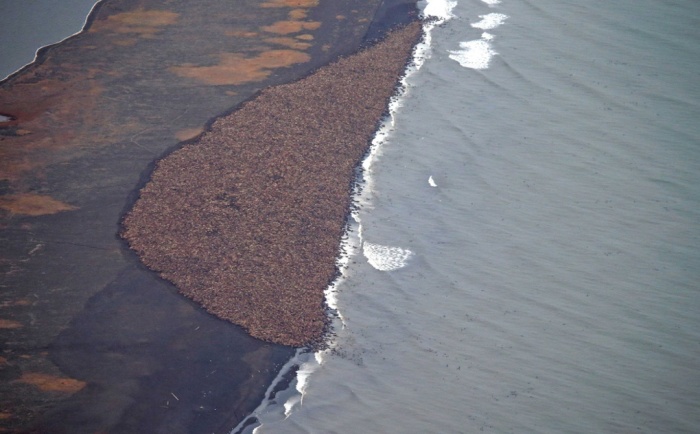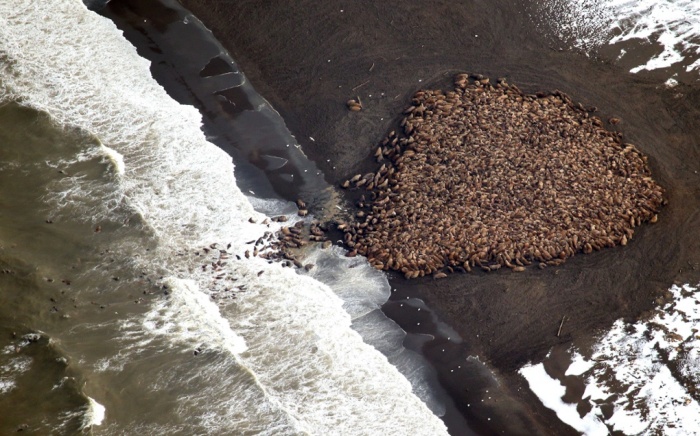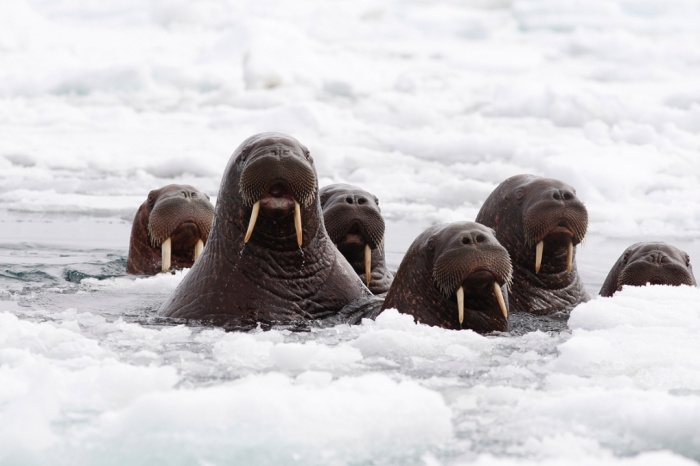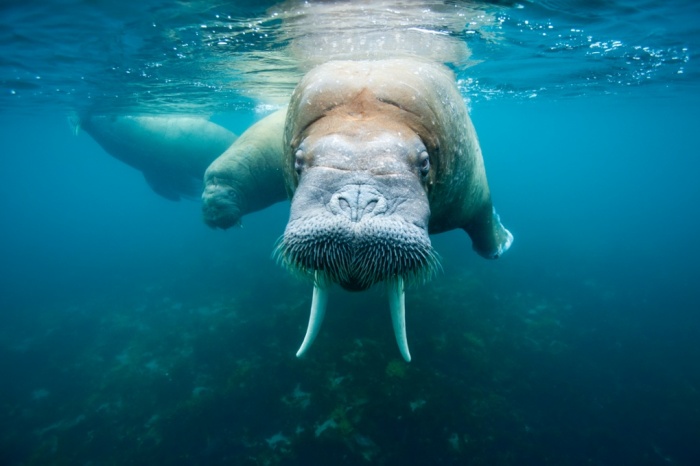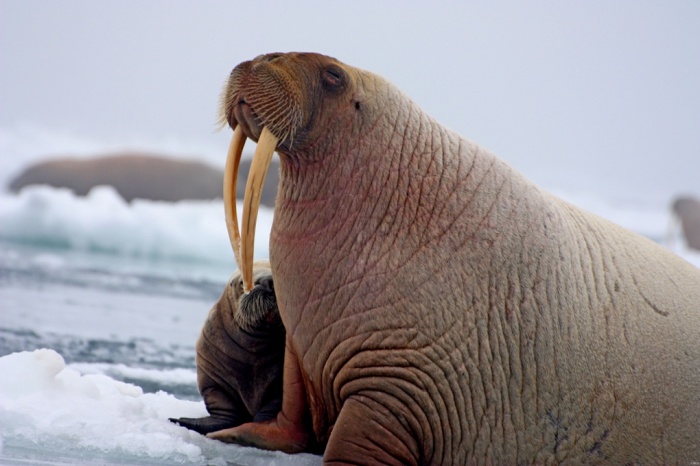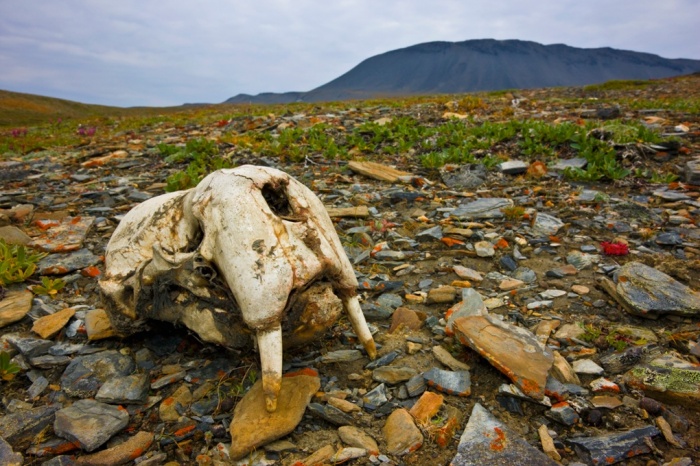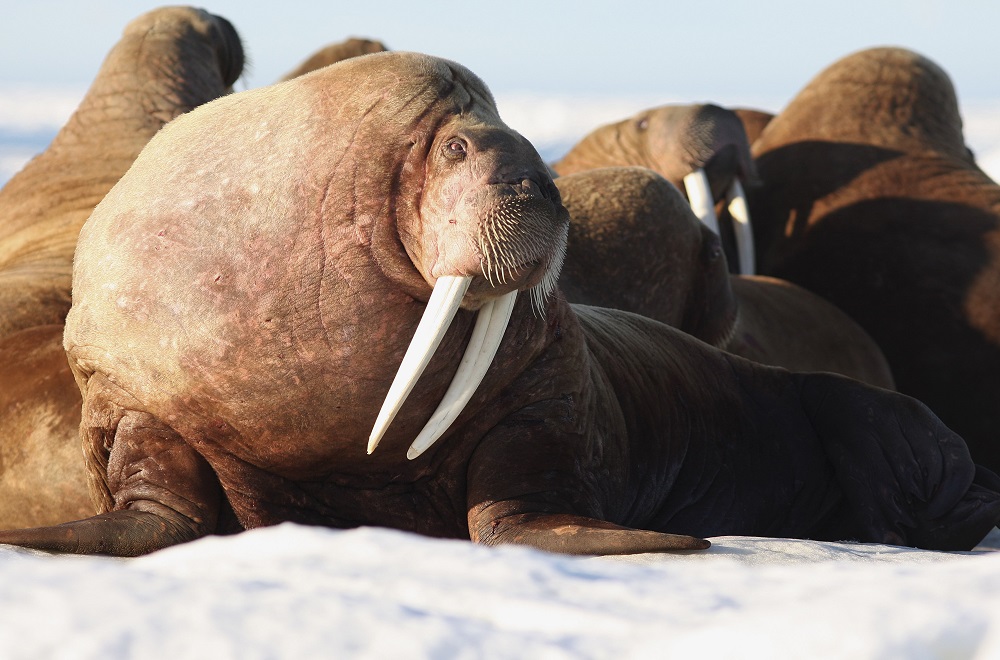[PHOTOS] Melting Ice Forces 35,000 Pacific Walruses To Haul Out Onshore In Alaska
In a vivid demonstration of the cascading consequences of manmade global warming, a record 35,000 Pacific walruses have hauled out of the Chukchi Sea onto a beach near Point Lay, Alaska
Earlier in September, a record 35,000 Pacific Walruses hauled themselves on a remote Alaskan coastline. The massive gathering was photographed as part of an annual survey undertaken by the US National Oceanic and Atmospheric Administration.
35,000 walrus gather on the shoreline near Point Lay, Alaska. Pacific walrus looking for places to rest in the absence of sea ice are coming ashore in record numbers on Alaska’s north-west coast
Image via guim.co.ukThis aerial photo taken on 23 September 2014, shows a gathering 1,500 on Alaska’s north-west coast
Image via guim.co.ukAndrea Medeiros, a spokeswoman for the US Fish and Wildlife Service, told the Associated Press wire agency that the animals' mass movement was first detected on 13 September, and that they have been moving on and off shore ever since.
Observers have reported seeing carcasses, which may be from dead animals killed in a stampede. The biggest of these tusked beasts can weigh in excess of two tonnes. Scientists were heading to the area to perform necropsies to determine the exact cause of death, Andrea Medeiros added.
Walruses are an ice-dependent species. They rely on it for everything from giving birth to diving down to reach the food below. But with sea ice having retreated far offshore, the Walruses have been forced to swim to land to be able to forage and rest.
Pacific walruses in the Chukchi Sea off the coast of Alaska in June 2014. Researchers are trying to improve their knowledge of the animal’s numbers ahead of an expected US Fish and Wildlife Service decision on whether they need special protection
Image via guim.co.ukWalruses, each of which can weigh more than 4,000 pounds, depend on sea ice for hunting food in deeper ocean waters and resting in between those dives, and the retreat of sea ice cover in recent years has helped push them ashore in increasing numbers in the Russian Arctic and now the Alaskan Arctic as well, biologists and climate scientists said.
Walrus haul outs in the U.S. have occurred in six of the last eight years, according to the U.S. Geological Survey. However, previous events were in far smaller numbers than the current event, on the order of a few thousand to about 10,000 marine mammals, according to Margaret Williams, who directs the World Wildlife Fund’s Arctic program. A study published last year found the 2011 haul out may have been as large as 30,000 animals.
While it's hardly the first big Walrus gathering to be documented, a fact well noted by climate change skeptics, scientists say the size of the gatherings are growing as climate change melts Arctic sea ice, depriving Walruses of their sunning platforms of choice
This is what #climatechange looks like. 35,000 walruses forced ashore: http://t.co/Nt2JfmrR4B pic.twitter.com/dNV3sIzRvV
— WWF (@WWF) October 1, 2014
"The walruses are hauling out on land in a spectacle that has become all too common in six of the last eight years as a consequence of climate-induced warming," the U.S. Geological Survey wrote on their website Wednesday.
"Summer sea ice is retreating far north of the shallow continental shelf waters of the Chukchi Sea in U.S. and Russian waters, a condition that did not occur a decade ago," the USGS website says. "To keep up with their normal resting periods between feeding bouts to the seafloor, walruses have simply hauled out onto shore."
Within hours of newspapers covering the striking photographs, the walrus and their reason for being on that forlorn shore became enmeshed in the politics of climate change. “This is what climate change looks like,” said WWF. Climate sceptics immediately produced evidence that showed the haul out was nothing out of the ordinary.
Both sides were guilty of simplification. But it is almost certain climate change forced the walrus ashore at Point Lay and it places the species’ future in jeopardy. The walrus, almost all of them females and calves, should be spending their summer on the fringes of the Arctic sea ice. But the ice is gone.
As the ocean heats up due to global warming, Arctic sea ice has been locked in a downward spiral, according to NatGeo
Since the late 1970s, the ice has retreated by 12 percent per decade, worsening after 2007, according to NASA. Walruses were first spotted coming ashore in large numbers in 2007. In 2009, an estimated 3,000 walruses were seen; the number rose to 30,000 in 2011 and went back down to 10,000 in 2013.
Scientists have seen large haul-outs on the Russian side of the Bering Strait for quite some time, says Anthony Fischbach, a wildlife biologist at the USGS in Anchorage. But since the first recordings of walrus gatherings in Alaska in the 1870s, groups of this size weren't observed until 2007, he said. May 2014 represented the third lowest extent of sea ice during that month in the satellite record, according to the National Snow and Ice Data Center.
Lori Polasek, a marine biologist at the Alaska SeaLife Center, a research and wildlife rehabilitation facility in Seward, says:
"Being in Alaska, climate change is very apparent. That's the reason why we have lost summer Arctic ice."
While it's not unusual for male Walruses to gather in large numbers on Alaska's shores, females typically prefer floating ice chunks as places to give birth, leaving calves on the ice when finding food
Female walruses and their young rest on sea ice between foraging bouts in July 2012
Image via guim.co.ukWalrus gatherings are also a natural occurrence, Polasek said. Walruses pull their bodies out of the water—or "haul out"—to rest or warm up on ice platforms or land. Hauling out is partially convenience and partially walrus nature, said Polasek. The stretch of beach near Point Lay is close to Hanna Shoal reef, a prey-rich foraging ground.
The giant marine mammals are gregarious and tactile animals, swimming side by side in the water and sprawling all over each other on shore. And when it's time to haul out, walruses tend to play follow the leader
"Until one brave soul is willing to haul, they're all looking around and wondering, 'Hey, did Bertha just haul out?' Wherever Bertha or that brave soul picks, within hours, they'll all begin to haul out to [that place]," Polasek said. "They just want to be with other walruses." Polasek predicts the herd will remain at Point Lay for two to four weeks. They'll return to the waters once winter ice begins to form.
However, haul-outs can be harmful to Walrus populations. For one, calves are particularly at risk of disease and from stampedes. Upon a disturbance, whether that's a polar bear or a boat in the distance, walruses tend to rush to the water.
Female and young walruses rest on the shore near Point Lay in September 2013, after sea ice disappeared from their offshore foraging grounds in the eastern Chukchi Sea
Image via guim.co.ukThe International Union for Conservation of Nature (IUCN), which tracks the status of species worldwide, says there's not enough information about walrus population trends to say whether the species—which has three subspecies, the Atlantic, Pacific, and Laptev walrus—is in decline. However, "climate change is expected to have negative consequences for Walruses, and particularly severe consequences for the Pacific subspecies," according to the IUCN website.
The skull of a sub-adult Pacific walrus lies on the rocky tundra near the shore of Wrangel Island in Russia, 2009
Image via guim.co.ukIn 2009, about a tenth of the walruses that hauled out died. This year, at least 36 walrus carcasses have been spotted, according to NOAA. That track record does not bode well for the species. "This shift to land of calf loss is large and population recovery is slow. If the ice continues to wane, they'll continue to come on land and you potentially have more stampedes. Then it'll be a pickle where [the population] can't recover," said Polasek.
Polasek added it's unlikely that the marine mammals can adapt to hauling out in large droves. Though there may be no way to prevent disturbances like polar bears and other predators, human communities can learn to adapt to the animal's growing presence on land, she said. "The village of Point Lay ... has laid out extremely concerted efforts to protect the herd," Polasek said. "They don't hunt in the herd. They direct vessel traffic away from the herd. They do everything they can to prevent human disturbances."
